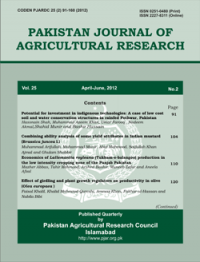COMBINING ABILITY ANALYSIS OF SOME YIELD ATTRIBUTES IN INDIAN MUSTARD (BRASSICA JUNCEA L.)
Muhammad Arifullah, Muhammad Munir*, Abid Mahmood**, Saifullah Khan Ajmal and Ghulam Shabbir*
ABSTRACT
Eight promising genotypes were crossed in all possible combinations using 8×8 diallel system for combining ability analysis. Data was recorded for seed yield and some important yield attributes. The results for combining ability analysis indicated significant general combining ability for most of the traits except plant height and siliqua length. UCD-8/4, KJ-119 and BRS-2 were good general combiners for yield related traits. A cross BRS-2 × UCD-8/4 showed best desired SCA for number of primary branches and siliquae per plant. S-9 × Canola Raya for siliqua length, Canola Raya × UCD-8/4 for number of seeds per siliqua, KJ- 119 × BRS-2, BARD-1 × NIFA Raya for 1000-seed weight while cross BRS-2 × UCD-8/4 for seed yield showed good positive SCA, involving at least one of the promising general combiner parents. It was suggested that selection should be delayed up to sixth segregating generation for number of primary branches, number of siliqua per plant, siliqua length and seed yield due to highly significant genotypic mean square and pre-dominant role of nonadditive type of gene action while for number of seeds per siliqua and seed weight, selection in early generations would be suitable due to prominance of additive gene action.
To share on other social networks, click on any share button. What are these?







